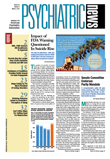The film focuses on 1934 Nuremberg, Germany—the day of a Nazi rally. Adolf Hitler is chancellor of Germany and a popular figure.
The film opens with Hitler flying in for the rally. (He was the first politician to campaign by plane.) As his plane touches down, masses of people are shown rushing to greet him. Then the film shows him moving by motorcade and zeroes in on the faces of some of his adoring fans. One can see the Hitler youth, in their knee-high socks, thumping drums and blowing trumpets, and then Hitler, faintly smiling and flipping his wrist, his usual haughty pose. And then comes a sweeping panoramic shot revealing hundreds of German soldiers marching to the rally.
This documentary, called “The Triumph of the Will,” was made by the German filmmaker Leni Riefenstahl, at Hitler's request. It is considered the greatest propaganda documentary ever made, John Hartman, Ph.D., said at the recent annual meeting of the American Psychoanalytic Association in New York City. He was the discussant at a session titled “Cinema and the Rise of Nazism: The Psychoanalysis of Propaganda.”
Hartman, a clinical associate professor of psychology at the University of South Florida, has been studying propaganda, especially hate propaganda, for some years now.
According to the dictionary, propaganda is the intentional spreading of information to either help or hurt a person, cause, or institution. Under this rubric, advertising, public relations, and even gossip might be considered propaganda. But hate propaganda has some unique characteristics, Hartman noted.
For one, it can be defined as “myths containing shared unconscious fantasies.” “The Triumph of the Will” is often referred to as “the Hitler myth.” There is the myth of righteous mission in the film. It's as though Hitler is saying, “If you sign on with me, you will be part of immortality.”
For another, the purpose of hate propaganda is to incite people to seek revenge against an enemy who is responsible for a threat. For example, Hitler had his propaganda minister, Joseph Goebbels, produce a film called“ Suss the Jew.” The film sends the message that Jews are conspiring to rule society and that revenge will solve this threat to the Germans' identity. The film was first shown in September 1940. Some 25 million people in Germany and occupied Europe are estimated to have seen it.
Hate propaganda, Hartman added, provides people with simplistic solutions. For instance, another Hitler hate-propaganda film, “The Eternal Jew,” which also appeared in 1940, depicts World War II as an apocalyptic battle between good and evil in which the Allies are part of the international Jewish conspiracy. The film was required viewing for German soldiers, members of the SS (Schutzstaffel), and concentration-camp guards.
This film, Hartman continued, also illustrates one of the techniques often used to spread hate propaganda: the blurring of fact and fantasy. For example, the Jewish actor Peter Lorre had played the part of a child killer in a 1931 film, so some clips from that film were incorporated into this one to make Jews look menacing. The film also shows several animals being cruelly slaughtered, implying that is how the Jews undertake Kosher slaughter and sending the message that “since the Jews kill innocent animals, we need to kill them before they kill us.”
One can assume that such films have a powerful, malignant influence on viewers. But whether that is true has not been documented scientifically, Hartman said. For instance, 65 percent of all European Jews are known to have been killed during the Holocaust. The intent of Hitler's hate films is clear from Goebbels' diaries. “But we don't have a way to measure the effect of the propaganda on the actual behavior” of the Germans carrying out the Holocaust, he said.
Nonetheless, Hartman has a good idea from his research of the types of people who are especially vulnerable to hate propaganda. They are individuals who have experienced war, a natural disaster, rapid social change, or some other threat and whose resultant feeling of endangerment leads them to regress psychologically. And once they have regressed psychologically, they may fall under the spell of a narcissistic leader, who promises to solve all their problems. Hartman calls it “a primitive form of transference.”
When Hartman started researching hate propaganda, he didn't think that it had much relevance for modern society. He has since changed his mind, he said. For example, radio was used to spread hate propaganda during the 1994 genocide in Rwanda, television was used to spread hate propaganda during the 1991-2001 Yugoslav civil wars, and currently Hezbollah's al-Manar television station in Lebanon is being used to disseminate hate propaganda against the Jews.
In fact, Hartman said, hate propaganda is being used today in everyday situations. When people make “us versus them” comments or say disparaging things about others whose backgrounds may be different from theirs, those are red flags that hate propaganda is being deployed. ▪
